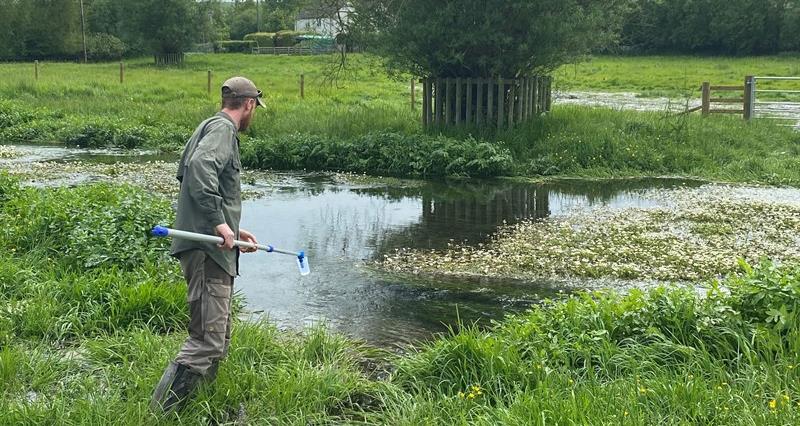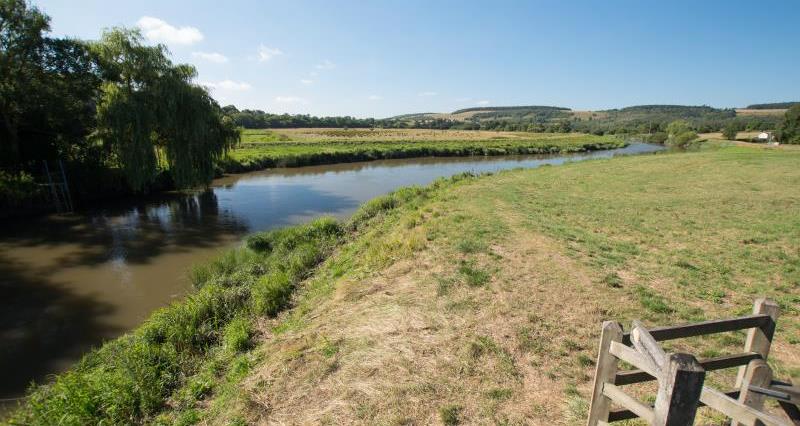The RSPRS (River Stour Phosphate Reduction Scheme) was launched around two years ago and operates as a cluster group focused on implementing targeted actions to reduce phosphate levels in the catchment.
Coordinated by dedicated individuals such as NFU member Mark Harvey – who manages an 860-hectare arable farm in the catchment – the scheme actively engages with farmers to adopt sustainable farming practices.
Challenges in the area
The River Stour catchment, situated in Blackmoor Vale, encompasses farmlands, woodlands, and water bodies, creating a diverse mix of ecosystems.
This region is important for wildlife and the local farming community, making sustainable practices crucial for the environment and the people who live there.
The catchment faces many challenges, with nutrient pollution being a significant concern.
The relationship between agricultural productivity and ecosystem protection frequently faces difficulties, requiring a considered and thoughtful approach to achieve balance.
“I’ve seen biodiversity increase considerably since the two years of the cluster group forming”.
NFU member and founder of the RSPRS Mark Harvey
A space to discuss successes & solutions
At the heart of the RSPRS lies the cluster group, with Mark Harvey as its founder.
Five years ago, Mark and NFU county chair for Dorset George Hosford entered a Countryside Stewardship scheme aimed at enhancing phosphate reduction.
From there, they encouraged other local farmers to follow suit, forming the cluster group two years ago.

Photograph: Since the group’s initiation, membership has grown as more farmers in the catchment commit to sustainable practices on their farm.
Comprised of those local to the catchment, the group brings together farmers from various backgrounds and agricultural practices.
It serves as a forum for knowledge exchange, mutual support, and collective decision making. Meetings are facilitated by chair of the group and Dorset farmer Claire Eastham and provide a space for farmers to discuss challenges, share successes, and explore innovative solutions.
“We have talks on what’s actually in the river, for example invertebrates, to make people aware of what’s in there and what all their functions are,” explains Mark.
Each member, regardless of farm size or agricultural focus, contributes to the collective goal of reducing phosphate levels in the catchment. Regular field visits and workshops allow the cluster members to gain practical skills and learn more about how they can implement sustainable practices on their farms.
Causes of pollution
The primary contributors to water pollution in the River Stour catchment are nutrient runoff, specifically phosphate, originating from agricultural activities.
The cluster group identified a number of factors contributing to this, including soil erosion, poor drainage, and the impact of fertiliser use.
The scheme has four core targets with the aim of addressing nutrient pollution and promoting biodiversity:
- Wildlife corridors: As part of the scheme, farmers are encouraged to create and maintain wildlife corridors on their properties. These corridors act as green pathways, connecting different habitats and allowing wildlife to move freely. Planting native vegetation and adopting wildlife-friendly management practices contribute to the development of vibrant and interconnected wildlife habitats.
- Biodiversity enhancement: The scheme places a strong emphasis on enhancing biodiversity within the catchment. Farmers actively participate in programmes that support the introduction of diverse plant species, encouraging a healthier ecosystem. This not only aids in nutrient cycling but also provides a more resilient environment for local flora and fauna.
- Pond restoration: Recognising the importance of water bodies within the catchment, the scheme includes initiatives for pond restoration. Farmers work to restore existing ponds and create new ones, contributing to improved water quality and habitat availability for aquatic species. These efforts aim to create a network of healthy and biodiverse aquatic ecosystems.
- Nutrient trapping: Implementation of nutrient trapping mechanisms, such as buffer strips and cover crops, is a key component of the scheme. These measures help prevent nutrient runoff by capturing and retaining excess nutrients, particularly phosphates, before they reach water bodies. This proactive approach not only safeguards water quality but also promotes sustainable farming practices.
Testing
Mark emphasises the importance of these core targets in lowering nutrient runoff: “Part of the focus of the cluster group is phosphate reduction, so as a group we do a lot of water sampling to see where we can improve our progress.
“Cover cropping is essential because as we’re on a floodplain – a high rainfall event would result in all the soil going into the Stour.”
The group tests for phosphate levels fortnightly to check their progress, as well as regularly monitoring soil runoff to seek areas of improvement. The implementation of these measures not only addresses the immediate challenges but also contributes to the overall enhancement of biodiversity within the catchment, helping produce diverse ecosystems.
Environmental benefits
“I’ve seen biodiversity increase considerably since the two years of the cluster group forming,” Mark continues.
“Being part of the cluster has helped develop members’ understanding around DAP (diammonium phosphate) application and effective usage, saving money as we’re now using less than what we’ve typically done before.”
Although financial benefits may not be immediately apparent for all members, the awareness and understanding of the environmental impact are deemed invaluable according to Mark.

Photograph: Example of the pondlife brought to the area by adopting sustainable farming practices.
The scheme has successfully created a platform for knowledge exchange and collaboration.
Farmers actively participate in meetings, sharing experiences and discussing diverse topics, from nutrient management plans to the intricacies of biodiversity conservation. Initiatives such as butterfly surveys and bird counts contribute to a holistic understanding of the catchment’s ecological health.
Future plans
Looking ahead, the RSPRS aims to further enhance biodiversity and reduce nutrient pollution.
The group envisions strengthening the cluster by expanding its membership and encouraging more farmers to join. Increasing biodiversity remains a key goal, with the challenge of developing robust metrics to measure and quantify success.
The group acknowledges the complexity of measuring progress, especially concerning the interplay between phosphate reduction and biodiversity enhancement.
Nevertheless, the cluster group remains committed to a dynamic and adaptive approach, fostering a continuous learning environment.
“Coming together as a cluster group has given us an insight on many various topics from river biodiversity to phosphate making us all more aware, both improving our businesses and understanding the habitat we farm in,” Mark adds.
As the scheme progresses, the hope is to inspire neighbouring farmers and catchment communities to adopt sustainable practices.
The River Stour catchment serves as an example of how collaborative efforts and proactive initiatives can make a meaningful impact on the environment while sustaining agricultural productivity.



